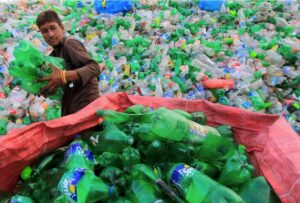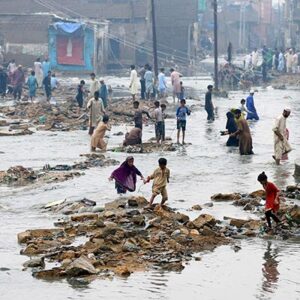Plastic bottling companies have executed a racket that spans the world, and everyone has bought into it. Both tap water and bottled water require energy to process in order to reach the end customer. According to environmental researchers Gleick and Cooley, the sum total of all energy inputs for bottled water requires anywhere between 5.6 to 10.2 million joules of energy per litre of water, depending on various factors, including transportation. What is nothing short of horrifying is that the same amount of water, when pumped through infrastructure, requires only 0.005 million joules; just add a filtration unit at the end. This 2,000 times factor is never brought up when discussing the topic of the environmental costs of bottled water.

Generally, we recognise and have almost accepted that the plastic required for the bottle is harmful as it requires anywhere between 450 to 1000 years to decompose, but we justify our use by saying we will recycle it. However, even as recently as 2020, less than 10 percent of the plastic bottles produced were being recycled globally. Most of us recognise the damage and harm of such actions, are aware of the dangers, but we still ‘pass the buck’ when it comes to environmental action and justify our own passiveness by hoping or expecting that others will come up with a solution to the problem. Many assume that the issue will not affect their lives directly, and that repercussions are way down the road.
But this is merely wishful thinking and the bitter truth is that climate change is already here and is impacting humanity as a whole. Those who are impoverished are inequitably facing more severe consequences, and we see more and more climate refugees around the globe, including Pakistan. However, the point of this article is not to raise awareness of the environmental crises, nor is it a list of ‘dos and don’ts,’ repeating ‘Reduce, Reuse, and Recycle.’ The aim here is to reframe the discussion on the approach to environmental action, and engage people to take the next step — locally and personally.
According to Global Climate Risk Index 2020, Pakistan is the 5th most vulnerable country to climate change due to its geographic location, high dependence on agriculture plus water resources, the low adaptive capacity of its people, and a weak system of emergency preparedness. With a population approximately 25 percent under the national poverty line, it is no wonder that the environment is not always at the forefront of action. And yet, it is the impoverished that are most vulnerable to the negative repercussions that spring from climate change. Everyone, regardless of their social rank, is affected by it e.g., when there is urban flooding in Karachi, and unbearable heat waves; or when certain crops fail due to pestilence or drought. However, the majority of decision makers on climate action, those who are in charge of what happens, when it happens and how, are safeguarded against the calamities of nature, and therefore their ‘inaction’ is not felt equitably by them.

The majority affected by such events does not have the resources, neither the knowledge of what to do, nor the political and social clout that will afford them the means to actually solve the problem and better their situation. This whole situation is compounded by the fact that most in Pakistan wholeheartedly believe that the onus of environmental action should be on the government. The intellectuals of Pakistan need to step up and be actively involved in addressing the issues, via local, small measures, so that change can then be expected on a grander scale from the government. This segment of society will continue to be the self-appointed critics of the authorities; however, some of these critics with megaphones in hand have nothing concrete to add when it comes to solving the problem. The Greta Thunbergs of the world are shouting from the sidelines, highlighting our inaction and its likely consequences, but many adults continue to remain passive.
Generally speaking, social issues and environmental issues have been considered two different spheres that have some overlap. However, for a country like Pakistan, in order to exact significant environmental change, we should approach the two together, and the lead should be taken by the “haves” of our society; whether in resources or in knowledge, or both.
In order to frame this new approach, the following needs to be understood. Given that:
• The first Billion Tree Tsunami Initiative started in 2014 in Pakistan and was achieved successfully in 2017 at a cost of US$ 169 million (World Economic Forum, 2017) — a massive collective of small initiatives where different groups planted trees throughout Khyber Pakhtunkhwa.
• The Environmental Restoration Fund was launched by the government in 2019 and its major goal now is the Ten Billion Tree Tsunami Programme, with the objective of creating 100,000 green jobs in the process; using a similar blueprint.
This means that such types of solutions, where we invest in small environmental cottage industry level solutions directed towards massive environmental change work and work well. Here we align the incentives of those without means and our overall environmental goals, such that their livelihoods are then dependent on keeping eco-friendly solutions sustainable.
This article sets out to reframe the solution to the environmental challenge by having the educated masses of Pakistan, both local and abroad, be at the forefront of solutions, directly overseeing the impact. We continue to get together at dinner and kitty parties, family gatherings, and at the club, therefore:
• Part of such socialising should include our coming together in groups, where we find partners to invest and organise with. We keep it local and thus we focus on people within the network of people we know (from domestic help in our homes and offices, to those whom we encounter on a somewhat regular basis).
• We get information about them, where they are originally from (i.e. what village etc.), what trees or sustainable source for energy is possible in that area or what sustainable green business could be set up.
• We secure resources and funds to help microfinance such endeavours.
• We take the time to go and educate the people in that village or area on how to keep green while sustaining incomes.
• We focus on empowering women specially to have green sustainable businesses, who then help elevate the status of a whole family and the trickle-down effects then mean more children going to school and less welfare required.
• And, most importantly, we continue to be a sustained source of support for these people — in terms of knowledge and problem solving.
Projects that we should look into vary in specialities and overall project size; and may be scaled up or down. These include investing in sustained forestry initiatives, where people cut down a percentage of trees to sell, while ensuring they plant a larger percentage in order to sustain the forests. They could include looking into various agricultural products from bamboo and hemp, to amaranths. These could include investing in bee keeping initiatives, or to recycling centres that source, sort, and cut plastics into various pellets and then melt them down to create products like chairs, tables, and benches that may be used in schools or homes. Other eco materials could include the fabrication of eco bricks that can then be used anywhere along the roads, to building small structures, to structures built in people’s gardens. We can communally buy land or ‘donate’ small parcels of our own gardens towards building ‘foodscapes’ or food focused agriculture so that we are growing food in our gardens for people, instead of having them buy. We can connect solar panels or wind turbines in villages and connect a business venture to the energy such that everyone is incentivised to keep the system running, rather than have it become a valuable to steal. The list of ideas is long, and each idea is able to be adapted to the local needs of the people and the environment, be it a village, a slum, or empty spaces in the communities that we already live in.
We all give sadqa, zakat, and all of us help other families we know. Part of what we give can now be organised to help generate sustainable income that comes from eco-friendly solutions. If this approach snowballs, so many social and environmental challenges in Pakistan can be overcome and we will have provided the initiation energy for this.

We are not reinventing the wheel here. These successful, local, initiatives have been taking place across the world for some time, and yet have not picked up enough momentum to become a truly global movement. Similar to the Billion Tree Initiative, one of the most successful ventures has been the Green Belt Movement (GBM) initiated by Wangari Mathai in Kenya, where her programmes focused on grassroots level sustained change and action. Her Community Empowerment and Education programme (CEE), educated scores of women about the linkages between human activity and the environment, and empowered them to unite, take action, and stand up for their rights. When communities understand the linkage between their actions, environment and their livelihood situations (poverty, water scarcity and soil loss and food insecurity) they are more likely to muster their energies and take action for change. Our providing resources to those who are indirectly connected to ourselves and our families allows them to undertake such business ventures that can actively help solve the problem.
The aim of this article is simple — it is to make people uncomfortable, but then focus their emotions towards solving the problem. The brilliance and resourcefulness of the Pakistani people, both in the country and abroad, as well as their patriotism and love for their country have never been in question, and are frankly admired by many across the globe. The question now is how each one of us can involve ourselves in actively changing the ‘scape’ of the land while helping its people grow.

The writer is a Kuwait-based Pakistani educationist, who has passed on her love for science to generations of youth and inspired many to take up the study of environmental science.



